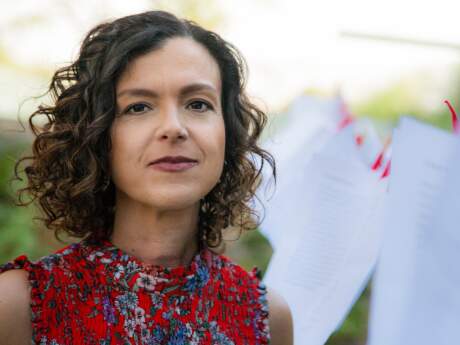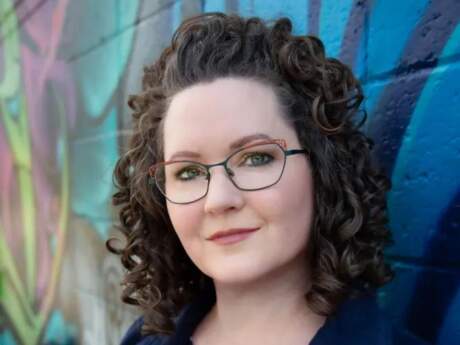In Their Own Words
Pimone Triplett on “Spieden Island, San Juans Boat Tour, Washington”

Spieden Island, San Juans Boat Tour, Washington
Among the many mannered spy toys
rendered to make
the viewer less visible
to the viewed—e.g., binocs, mics, mini-
cams, my high-strung home
security system bleeping
in tongues when I drive away--
the ones I love most
are those pricey round owl-eyed
sunglasses
Jackie O. found for her famous
face, a low-tech way
to watch the watchers back
unwatched.
Behind the look of almost eye-
patches awarded the post-op burn victim,
bivouacked by her life
and times and more than,
something there was that widowed a people.
See now how our tour guide nudges
up her nose bridge the neon-green
wrap-arounds of her perspective.
The mother and son whales
are celebrities.
Nikons, iphones raised to
follow the animals' scimitar fins
slicing in tandem through still water:
the mother's
white on black "eyespot" oval
alters a pattern I had in mind.
Our leader is called Katherine
or Kathleen or Kath or Katie or Kay.
She tells us "it's the Sunglass Hut
mega mogul who owns
that two mile island across the bay."
The Frames of Your Life.
"He's a very private person,
all Humvees with machine guns but," she adds,
"I'd really like to meet that guy,
one naturalist to another."
Where are you from? What is your favorite
part of the country? When I spot three
small black shapes
on shore, cat-sized, with pointy
bulbous rumps
like the rear headlights of a vintage
Cadillac, Kate tells me they're imported
Japanese mini-deer, brought here
for exotic game hunting, brain-children
of the island's previous owner,
John Wayne.
The Duke dreamt of private
shooting through these archipelagoe'd
waters
of a western Washington day. Mouflon sheep
and goats from Ghana,
equally displaced, make
at dusk the best of
the island's gritty barren side.
In True Grit, though Wayne
falls from his horse,
drunk again,
about hunting he was never wrong,
the asshole. Which America
do you love the most? Think
how it seemed to the animals,
my father says on the ferry way back.
Something there was, a people,
required.
The deer terrified by this below-hoof hardness
moving not right for so long
and then rock and sand and sun
bright paining and the feeder
comes no more.
In the old movie, it's the fatherless girl
who says, Who knows
what's in a man's heart.
Also, glare shellacs
the open oil dribble from our boat
peacock purple, apple green.
Put on your dark glasses.
America, which America
do you hate the most?
Some animals stay.
Others awayed by men. In the sandy places
many of our black shapes
shot down.
Several species have been removed. Hold on
to railings as you disembark. This way,
little syllable, this way.
On "Spieden Island, San Juans Boat Tour, Washington"
"Spieden Island…" was more of a collective gathering on my part inspired by overhearing many different speech acts—the naturalist guide who asks questions, provides information, voices aspirations, the father prompts thinking towards the end, and then the approximations, or half translations, of the imagined inner thoughts of the sheep.
The impetus for the poem in "real life," as the title suggests, was one of those whale watching tours that you can charter around the gorgeous San Juan Islands off the west of the Washington state coast.
The piece appears in the collection called Supply Chain. In this book, I'm interested in the overlap between ordinary spaces and the sometimes ambiguous undercurrents of both damage and invention within them. I was also trying to sense these spaces through a singular (lyric) perspective that is nevertheless overtly constructed by a community, as well as by the ways in which we sometimes fail to make community. I wanted to somehow track the journey toward empathy for another creature, along with whatever feeling of personal responsibility may come with it, while resisting the urge to overlook the limits of the individual lyric speaker, especially when it seems to have to function in isolation from a more collective voice. In this project I wanted to think about and feel toward the increasingly complex, interlocking network of connections that goes into the making of so many of our objects or places—a chain, in you will, of technology, yes, but also the many facets of surveillance, history, and finally language itself by the end of this particular poem.
I think so many of us have an extraordinary feeling of cultural disconnectedness, of our being split into several Americas, the subcultures that you love and the ones that you hate, and those feelings came into play in this piece. How do the smaller decisions we make, whether to photograph an animal or hunt it, for example, effect the psyche and landscape? How is it still possible to go deeper than the self-protection of mere observation—nature as spectacle—to risk letting yourself be seen and seen through? Much of our contemporary thinking has been concerned with how the self is constructed from the "other" within and the "other" without. Along these lines, what is at stake in even the smaller gesture of asking a question as opposed to asserting an answer, and how do these moments factor into a cultural fabric that has always already been made for us? Further, what does it mean to live with these more or less constant mixed-feelings about ourselves in our environment?
There aren't unambiguous solutions in this kind of ethical field and so I could feel early on this piece would be a more layered shaping process, asking me to notice or invent several visual and ideational echoes (the image of eyes protected but watching, the sunglasses, surveillance, the killer whale's "eyespot," etc.) or pairs of opposites (Jackie Onassis vs. John Wayne, or the toxic masculinist acquisitiveness vs. the benign example of my own father's question). I wanted to create a kind of vibrating scale between these various modes along which the self has to slide daily—between the visual act of looking and seeing, the being caught out looking, being seen, the split between commerce and naturalist mindset, power and its uses. And of course the cultural punning that comes towards the end, the primary and secondary resonances of a country in which the "black shapes [are] shot down," is intentional.
It's true that during the boat tour our guide mentioned how one of the smaller islands, among the several who have had private owners of the years, had been owned at one time by John Wayne. Apparently someone had the idea to turn the island into a private sanctuary for the hunting of wild game. Exotic animals were indeed imported onto this tiny two mile island for this purpose. Somewhere in the planning stages local residents objected to the prospect of gunfire within a relatively well traveled waterway, and the project was abandoned. However, in the subsequent process of removing the game animals some were left behind (perhaps inevitably), in particular the smaller among them like the goats from Ghana and Japanese miniature deer about the size of cats. Several of these species left behind survived to prosper and propagate throughout the islands.
Part of this braiding of voices includes for me the cultural elements of John Wayne, that figure of the American west who, in his present day (supposed) out-datedness, has somehow aged poorly as a cultural icon. He is the exaggerated "heroic" everyman, gruff but semi-glamorized, embodying the off-handed racist expansionism that is so aptly critiqued by James Baldwin as personifying white supremacy in its most unthinkingly lethal aspects. Of course, there are many iterations in this kind of American figure, "the asshole" (in the poem's phrasing, the rhythmic allusion to the opening of Auden's "Musee Des Beaux Arts" was irresistible). The act of re-watching a film like True Grit came out of an initial feeling that I had to use my own father's comment at the time when hearing about Wayne's transportation of the exotic game creatures: "Think/ how it seemed to the animals." I still like the proximity of the more destructive male figure of Wayne alongside, however (necessarily) briefly, the more benign father figure who asks a question that prompts the imagination and the muscle of empathy to start working. Our naturalist also mentioned how the island is currently owned by the entrepreneur behind the Sunglass Hut stores that seem ubiquitous in what's left of American malls. Her comment helped push the opening of the poem more explicitly toward the power dynamics of looking.
A fair amount of incremental work and structural thinking went into piecing the elements of the poem together. I feel this is the kind of language linking work that is most successfully done in revision and over the course of many drafts. I don't mind a poem seeming more cooked than raw, so long as a sense of the language stays surprising, energetic, associative, or seems a "moment's thought," as Yeats would have it.
It may seem overly pessimistic to link the extremities of the human desire to control the environment with the start of the basic unit of language, the syllable. Increasingly though, it feels apt to begin to find likenesses between life forms and language systems, to understand each as profoundly interdependent systems, to see difference as primarily meaningful only when it is relational. Grappling with what is not easily resolvable into isolated ethical categories, seeing a linguistic unit, the syllable, as both integral to the species-long process that may lead to our planetary demise and yet simultaneously a necessary building block for love, empathy, and cooperation, to me, this is part of how poetry can serve to make the personal more complex.



